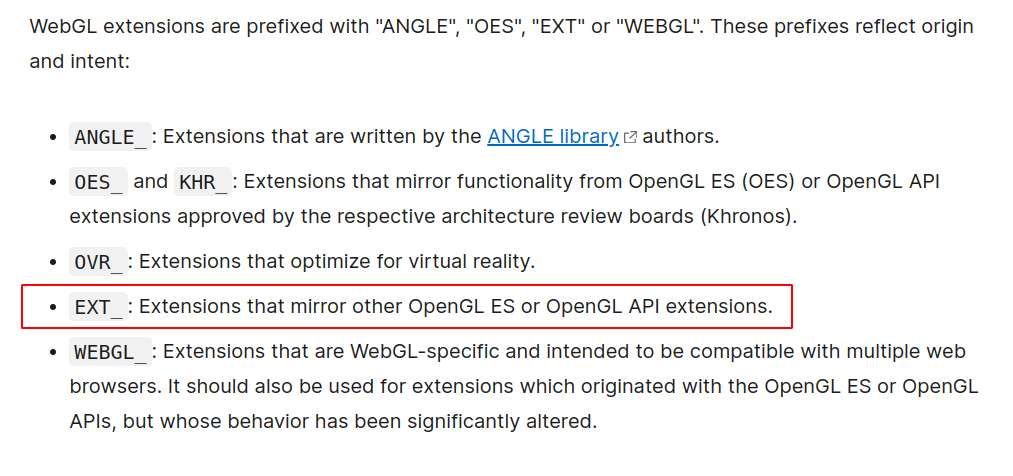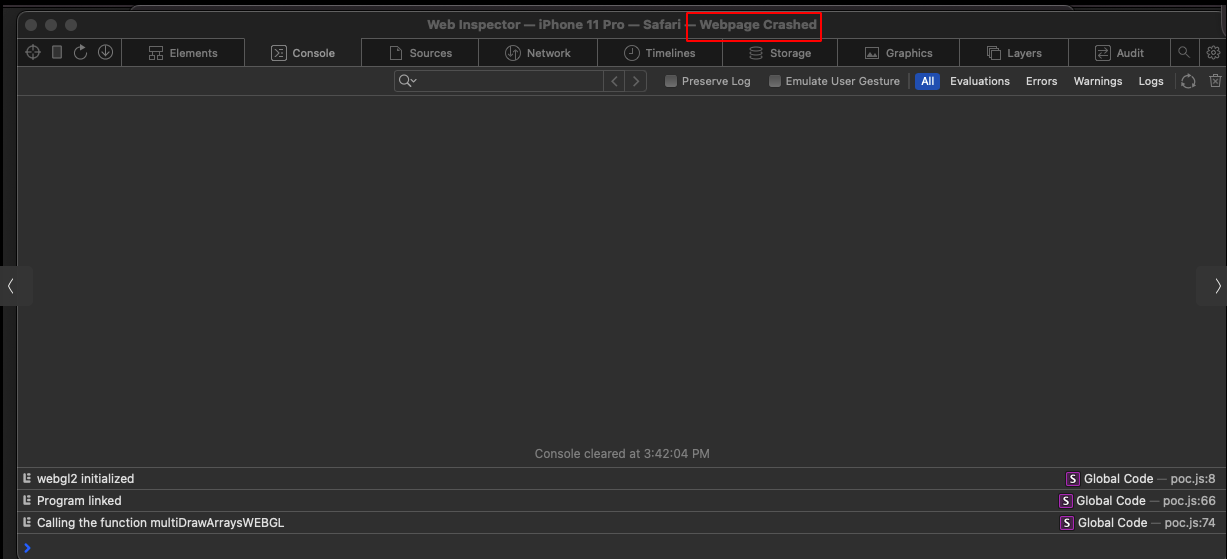This post is about the poc for the WebGL bug that was patched in Safari 15.4 security updates.
If you want to learn in detail about how WebGL works, you can use this official resource since we are going to discuss bug specific details here :
https://webglfundamentals.org/webgl/lessons/webgl-how-it-works.html
This poc is not about how to get the primitives to exploit this bug, we will just discuss about vulnerablity analysis and how to crash the webcontent : )
WebGL is a javascript API that is used in browsers to render 2D and 3D graphics. It uses ANGLE component as its primary WebGL backend, significantly improving compatibility with other browsers, and enabling a conformant WebGL 2.0 in WebKit. WebGL offers a lot of extensions for a developer to perform the rendering with optimisations. So, we will look into the extension of which we are concerned about.
So, this api provides several extensions for different intents. The bug we are going to discuss is in EXT_.
You can read more in detail about the extensions from here :
https://developer.mozilla.org/en-US/docs/Web/API/WebGL_API/Using_Extensions
Anyway, let's move towards the bug :)
The WEBGL_multi_draw extension is part of the WebGL API and allows to render more than one primitive with a single function call. This can improve a WebGL application's performance as it reduces binding costs in the renderer and speeds up GPU thread time with uniform data.
This extension exposes the
Multi*draw call variants inEXT_multi_draw_arraysfunctionality in addition to the vertex shader builtingl_DrawIDexposed byARB_shader_draw_parametersfor OpenGL.These functions behave identically to the standard functions
DrawArrays()andDrawElements()except they handle multiple lists of vertices in one call. Their main purpose is to allow one function call to render more than one primitive such as triangle strip, triangle fan, etc.Additionally, this extension adds a further built-in variable,
gl_DrawIDto the shading language. This variable contains the index of the draw currently being processed by aMulti*variant of a drawing command.
You can read more details about the extension here :
https://registry.khronos.org/webgl/extensions/WEBGL_multi_draw/
This extension is similar to the webgl api WebGLRenderingContext.drawArrays() and WebGLRenderingContext.drawElements() etc, that renders primitives from array data. The only difference is that we can render using this extension using multiple arrays.
We can perform these operations using this extension: [1]
-
ext.multiDrawArraysWEBGL()renders multiple primitives from array data (identical to multiple calls todrawArrays). -
ext.multiDrawElementsWEBGL()renders multiple primitives from element array data (identical to multiple calls todrawElements). -
ext.multiDrawArraysInstancedWEBGL()renders multiple primitives from array data (identical to multiple calls todrawArraysInstanced). -
ext.multiDrawElementsInstancedWEBGL()renders multiple primitives from element array data (identical to multiple calls todrawElementsInstanced).
https://github.com/WebKit/WebKit/commit/c087ca07c9125093ca62e8e44024b738bb7d46dc
The vulnerability exist only from Safari 15.0 to 15.3 because this extension is only supported in Safari 15 (ios) in case of apple.
The patch is very easy to understand and it clearly states that it is a heap buffer overflow while rendering. This function is called here in WebGLMultiDraw.cpp in all the operations we mentioned above [1]. Let's understand what's happening before this function being called. We may look into one of the above function's implementation :
void WebGLMultiDraw::multiDrawArraysWEBGL(GCGLenum mode, Int32List firstsList, GCGLuint firstsOffset, Int32List countsList, GCGLuint countsOffset, GCGLsizei drawcount)
{
if (!m_context || m_context->isContextLost())
return;
if (!validateDrawcount("multiDrawArraysWEBGL", drawcount)
|| !validateOffset("multiDrawArraysWEBGL", "firstsOffset out of bounds", firstsList.length(), firstsOffset, drawcount)
|| !validateOffset("multiDrawArraysWEBGL", "countsOffset out of bounds", countsList.length(), countsOffset, drawcount)) {
return;
}
m_context->graphicsContextGL()->multiDrawArraysANGLE(mode, makeSpanWithOffset(firstsList, firstsOffset), makeSpanWithOffset(countsList, countsOffset), drawcount);
}In JS, the function specifications are defined like this :
void ext.multiDrawArraysWEBGL(mode,
firstsList, firstsOffset,
countsList, countsOffset,
drawCount);-
mode:gl.POINTS: Draws a single dot.gl.TRIANGLES: Draws a triangle for a group of three vertices.
-
firstsList:- An Int32Array or Array (of GLint) specifying a list of starting indices for the arrays of vector points.
-
firstsOffset:- A GLuint defining the starting point into the firstsLists array.
-
countsList:- An Int32Array or Array (of GLsizei) specifying a list of numbers of indices to be rendered.
-
countsOffset:- A GLuint defining the starting point into the countsList array.
-
drawCount:- A GLsizei specifying the number of instances of the range of elements to execute.
Looking into the implementation, we can see that we can control the offset and drawcount to draw mode past the size of buffer : )
So, our POC goes here ...
As you can see, our webpage just crashed since the validateOffset() called in multiDrawArraysWEBGL() doesn't check if our firstsOffset is in the range of [0, size-drawcount] and we are drawing past the size of of actual buffer. The function call m_context->graphicsContextGL()->multiDrawArraysANGLE() is implemented in third party components for WebKit known as ANGLE and it doesn't have any checks before rendering, so we crash writing some bad value to the memory region.
FYI, multiDrawArraysANGLE() pseudocode works like this:
for(i=0; i<drawcount; i++) {
if (*(counts+i)>0) DrawArrays(mode, *(firsts+i), *(counts+i));
}And with the patch applied, it won't render anything and return false through the validateOffset() function call:
js) ...
PARS Defense Team
We're hiring new team members, contact us: info[at]parsdefense.com




